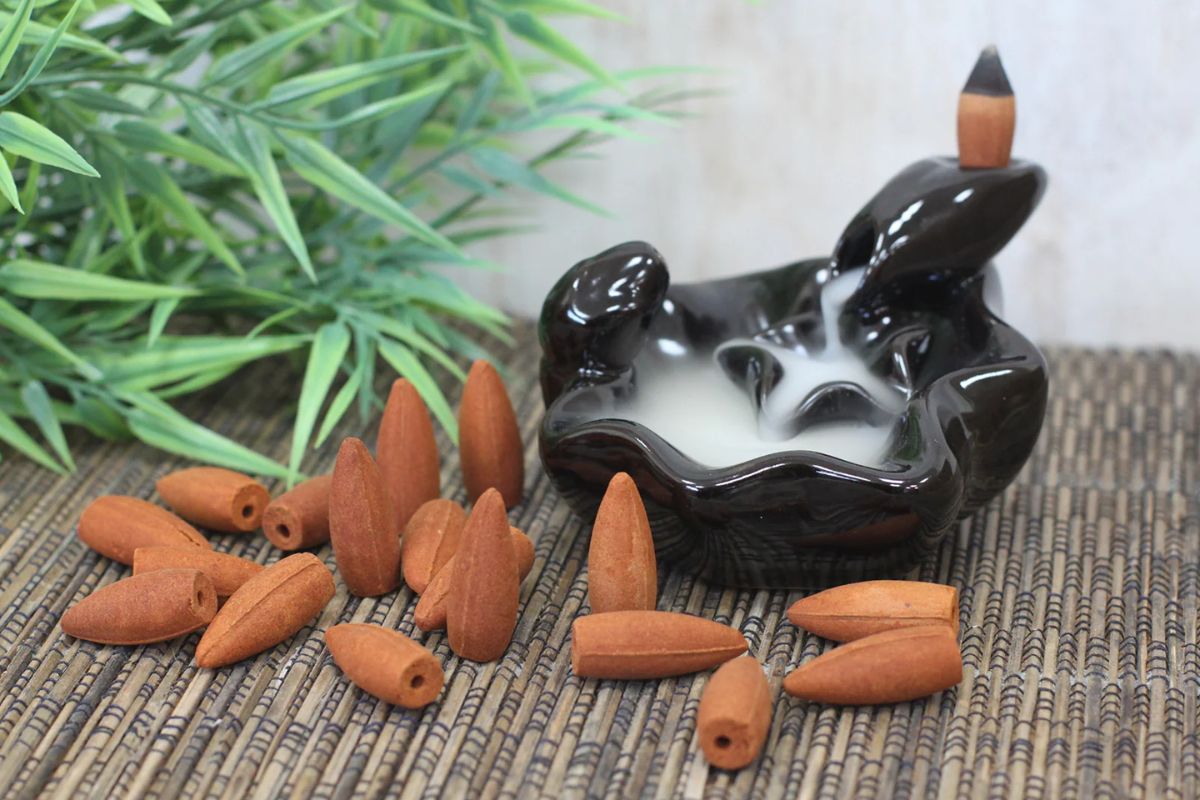Backflow incense cones have become increasingly popular for their mesmerizing smoke waterfall effect, creating a calming and almost magical atmosphere in any space. Unlike regular incense, these specially designed cones release smoke that flows downward, cascading beautifully through a backflow incense burner. Whether you’re using them for meditation, relaxation, or simply as a unique decorative touch, learning how to light and burn them correctly is essential for the best results. In this guide, you’ll discover step-by-step instructions, safety tips, and cleaning advice to ensure a smooth experience every time. Enjoy the soothing fragrance while watching the enchanting downward smoke effect unfold.
Ever watched smoke flowing downward like liquid silver? Backflow incense cones create this mesmerizing phenomenon that transforms ordinary aromatherapy into visual poetry. Unlike traditional incense sticks that send smoke upward, these specialized cones engineer gravity-defying displays.
This comprehensive guide reveals secrets behind waterfall incense mastery. You’ll discover lighting techniques, troubleshooting solutions, and maintenance wisdom that creates perfect cascading smoke every time. Whether you’re seeking meditation tools or decorative enhancement, this knowledge elevates your spiritual practice.
What Are Backflow Incense Cones?
Backflow incense cones are special incense cones with a hollow tunnel design running through the middle. Unlike normal incense, they are designed so that smoke travels downward through this tunnel. When placed on a backflow incense burner, the tiny particles in the smoke become heavier than air and create the signature waterfall effect.
Many people confuse backflow vs regular incense. Regular cones or sticks release smoke upward, while backflow fountain cones push the smoke downward. This creates a calming atmosphere that feels like watching a mesmerizing waterfall effect.
Unlike conventional meditation incense that disperses smoke upward, backflow incense burners harness fascinating physics principles. Dense, cooled smoke particles cascade downward through strategically drilled passages, creating theatrical fog-like displays. This signature waterfall effect transforms mundane spaces into tranquil sanctuaries perfect for mindfulness practice.
How Do Backflow Incense Cones Work?
The secret is in the incense cone composition. These cones use special materials that produce thick, heavy smoke. When you ignite incense tip and place it over the bottom hole alignment of the burner, the smoke enters the hollow tunnel and slowly flows down.
The air temperature, smoke density, and airflow circulation around the burner all affect how smooth the cascading plume looks. For best results, always place your burner in a draft free environment and on a heat resistant surface.
Step-by-Step Guide: How to Burn a Backflow Incense Cone
Burning backflow incense cones is simple once you know the right process. Unlike normal incense, these cones are designed with a hollow tunnel design and a small bottom hole alignment. That’s why you need to follow the right method to get the signature waterfall effect.
Step 1: Use a Backflow Incense Cone Burner
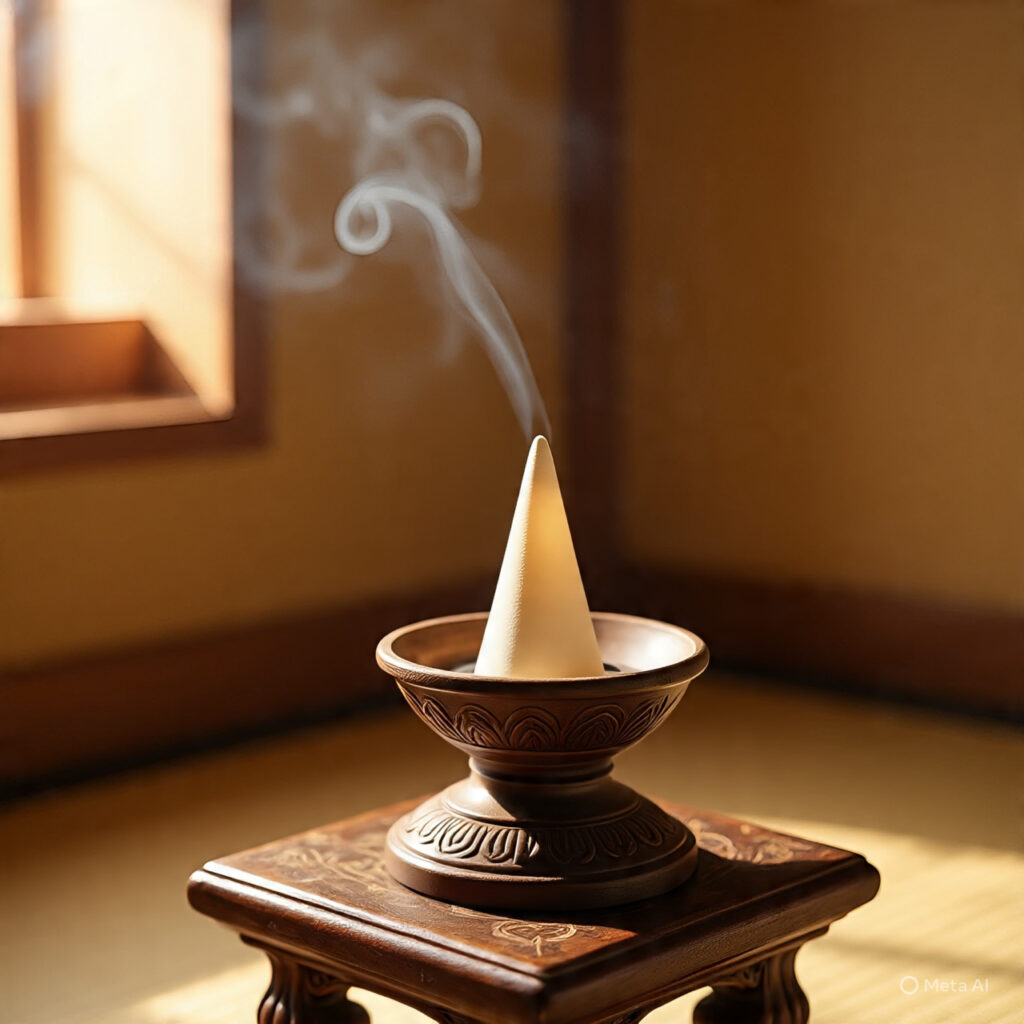
You cannot place these cones on a normal incense holder. A backflow incense burner or incense fountain is required because it has a special channel that guides the downward flowing smoke. Regular holders are made for sticks or upright cones where the smoke rises up, while a waterfall incense burner allows the smoke flows downward to create that cascading smoke effect.
Step 2: Place the Backflow Incense Cone Properly
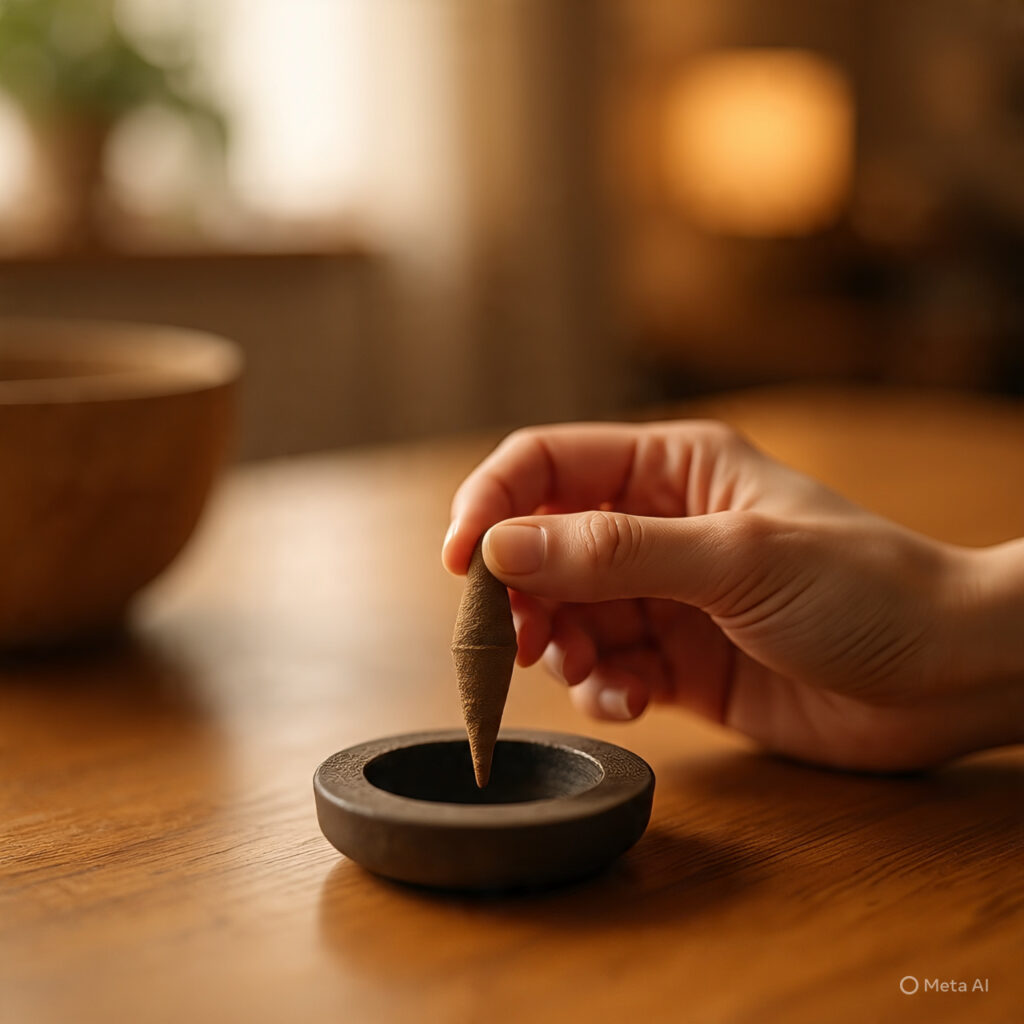
Set the cone on the small hole of your backflow fountain. The bottom hole of the cone should match the hole on the burner. If it isn’t aligned, the cascading plume won’t work. Make sure the cone sits firmly and that no ash blocks the airflow, as proper alignment is the key to the incense smoke waterfall.
Step 3: Light the Backflow Incense Cone
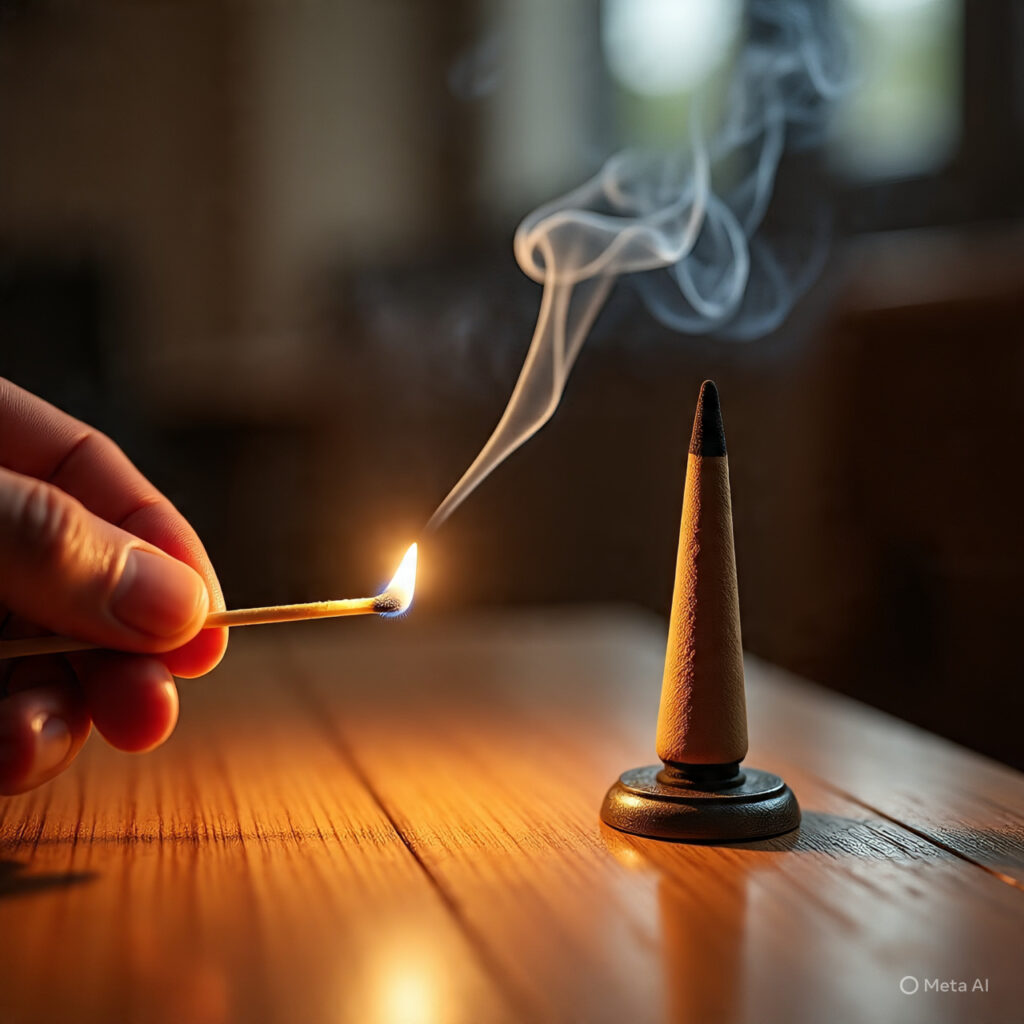
Hold a match, lighter, or candle to the tip of the cone. This part is known as the incense lighting process. The goal is to ignite incense tip without letting it burn like a candle. Always burn incense safely on a heat resistant surface and away from flammable materials.
Step 4: Let It Burn Briefly and Blow Out the Flame

Allow the flame to burn for about 10–15 seconds. This helps form a glowing ember inside the cone. Then, gently blow out flame so only the red ember remains. If you blow too hard, the ember may die out, and you’ll need to repeat the incense cone lighting method.
Step 5: Check for a Glowing Ember and Ashen Tip
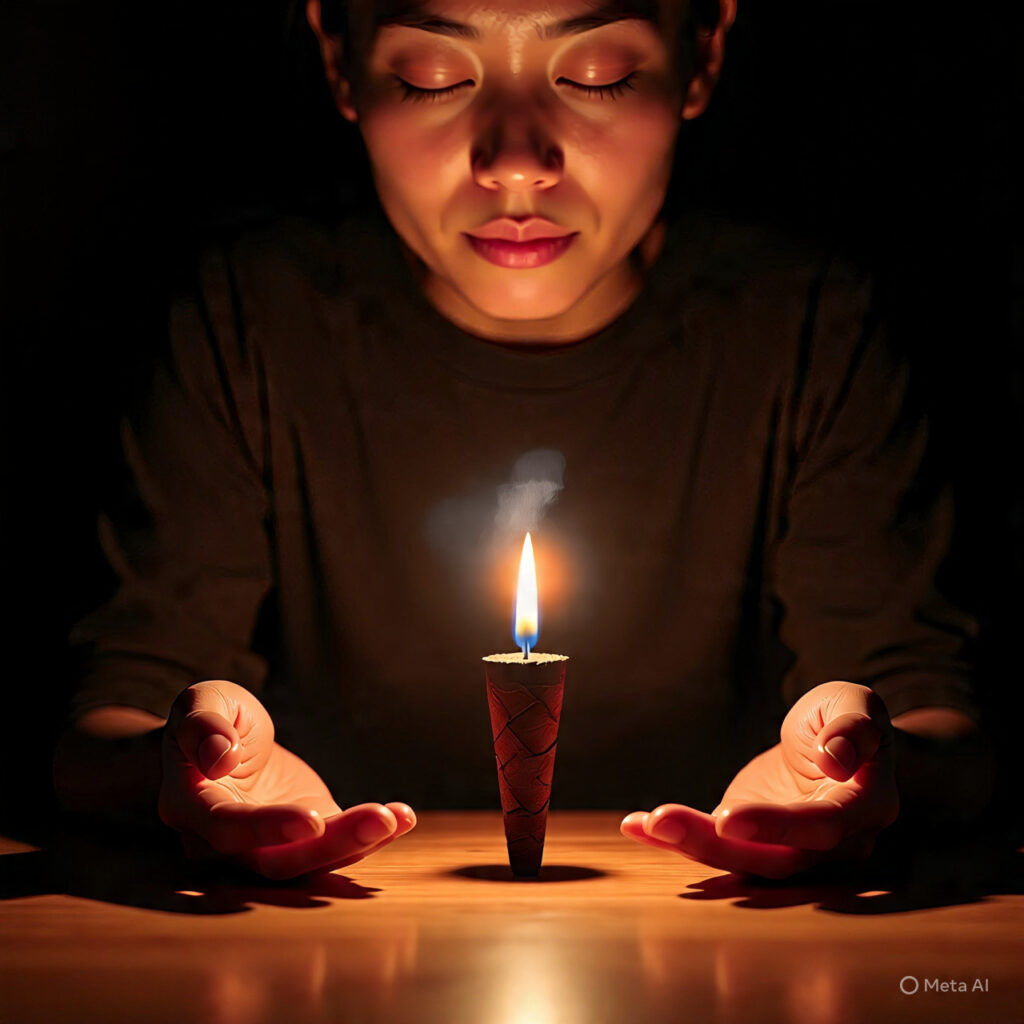
After you extinguish the flame, the tip of the cone should look grayish-white. This means the ember formation is correct. If your incense won’t stay lit, it could be because of oil absorption, excess resin buildup, or poor airflow. Relight it if needed until you see the ashen tip.
Step 6: Wait for the Smoke Flow
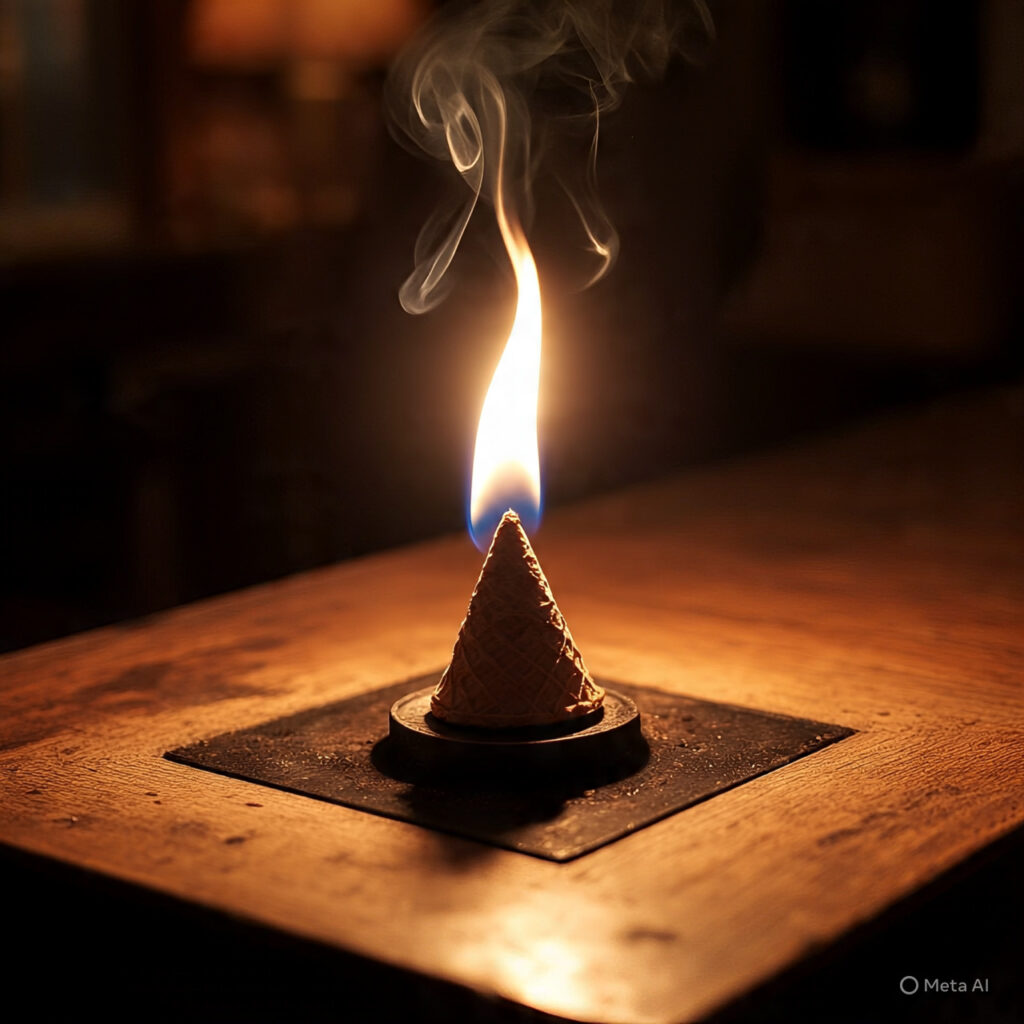
Patience matters here. The cone needs about one minute for the tiny particles in the smoke to cool down and create the smoke density required for the backflow effect. Don’t panic if you don’t see the waterfall effect immediately. A well ventilated space but draft free environment helps the process.
Step 7: Watch and Enjoy the Cascade Effect
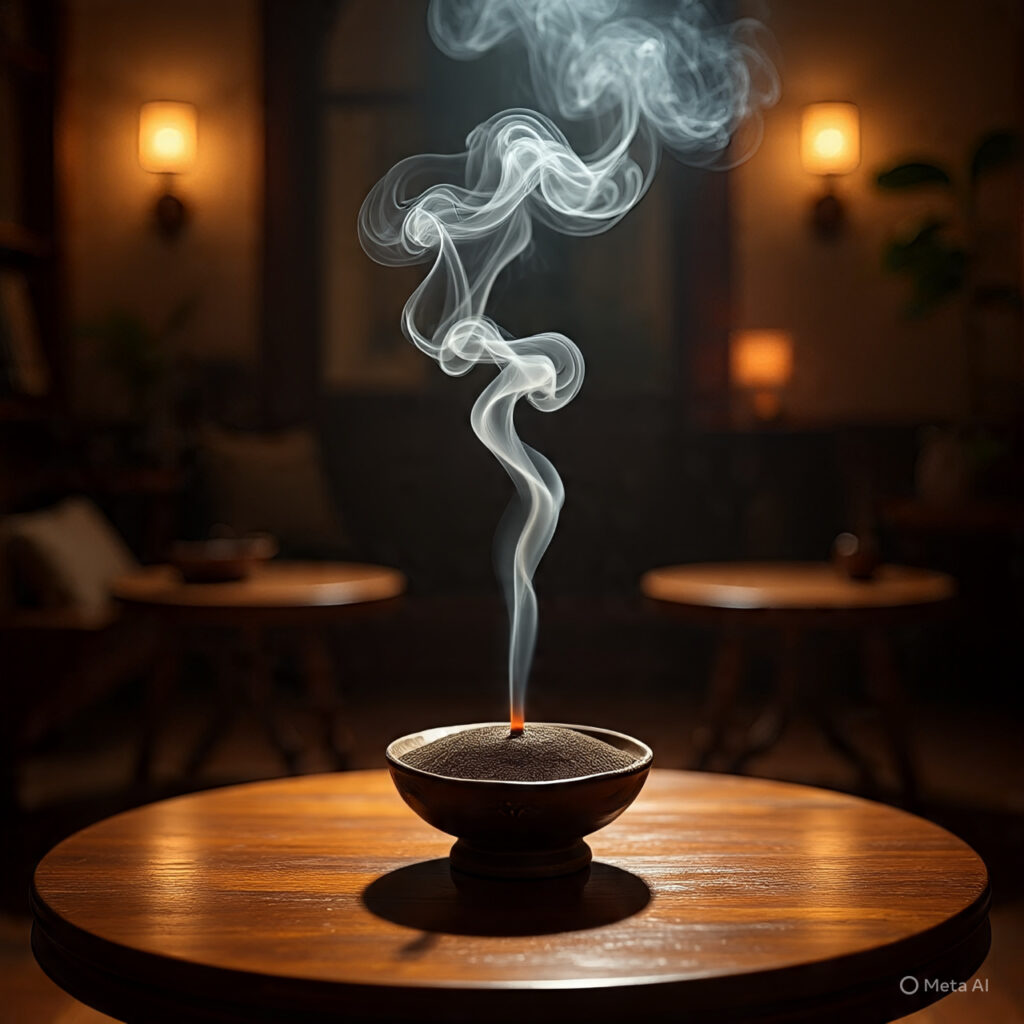
Once it begins, you’ll see the mesmerizing waterfall effect. The cascading smoke flows down like water and collects at the base of the dragon incense waterfall or ceramic burner. The result is a calming sight and a soothing effect that makes it perfect for a meditation incense or aromatherapy session.
Step 8: Be Aware of the End of the Burn
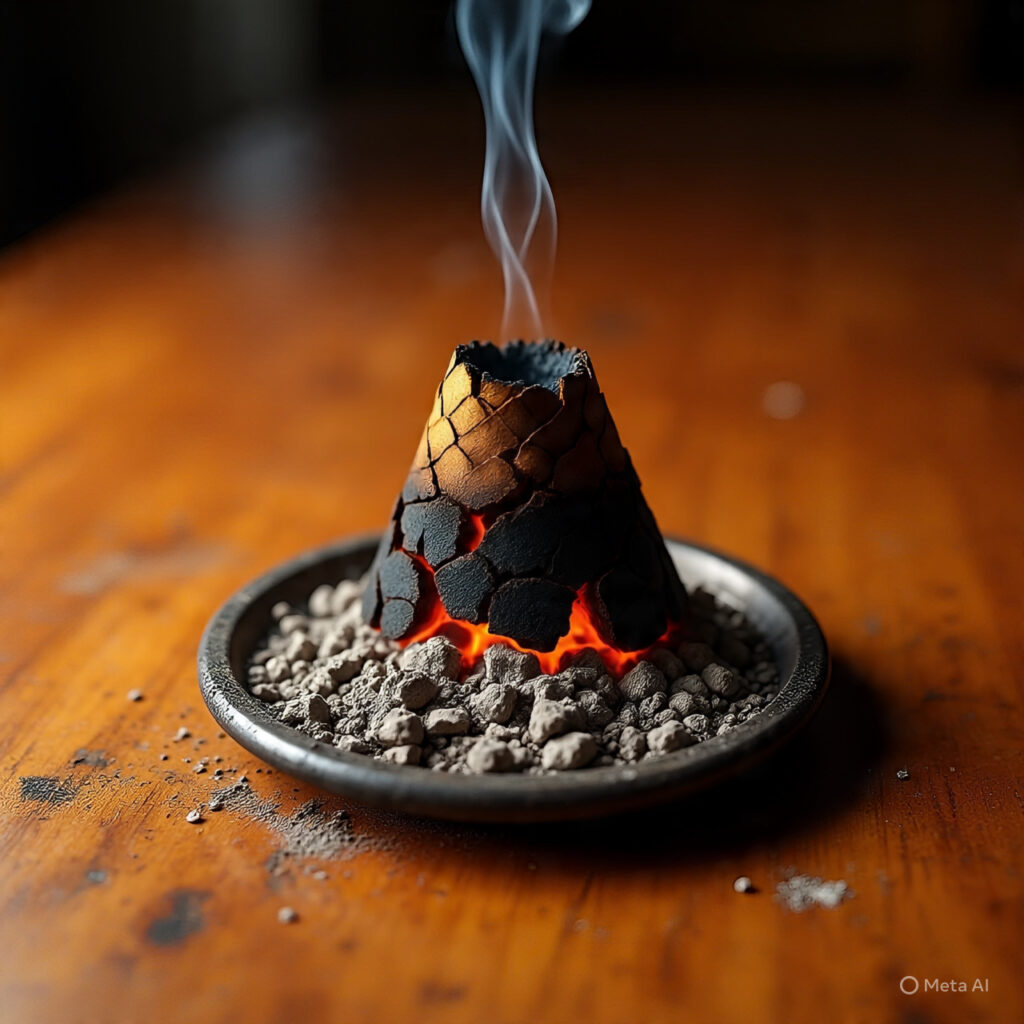
When the cone is nearly finished, the ash formation becomes loose and can crumble. Always practice fire safety and avoid leaving burning incense unattended. Let it cool completely before touching or disposing of the incense ash.
Step 9: Clean Up Residue and Ashes
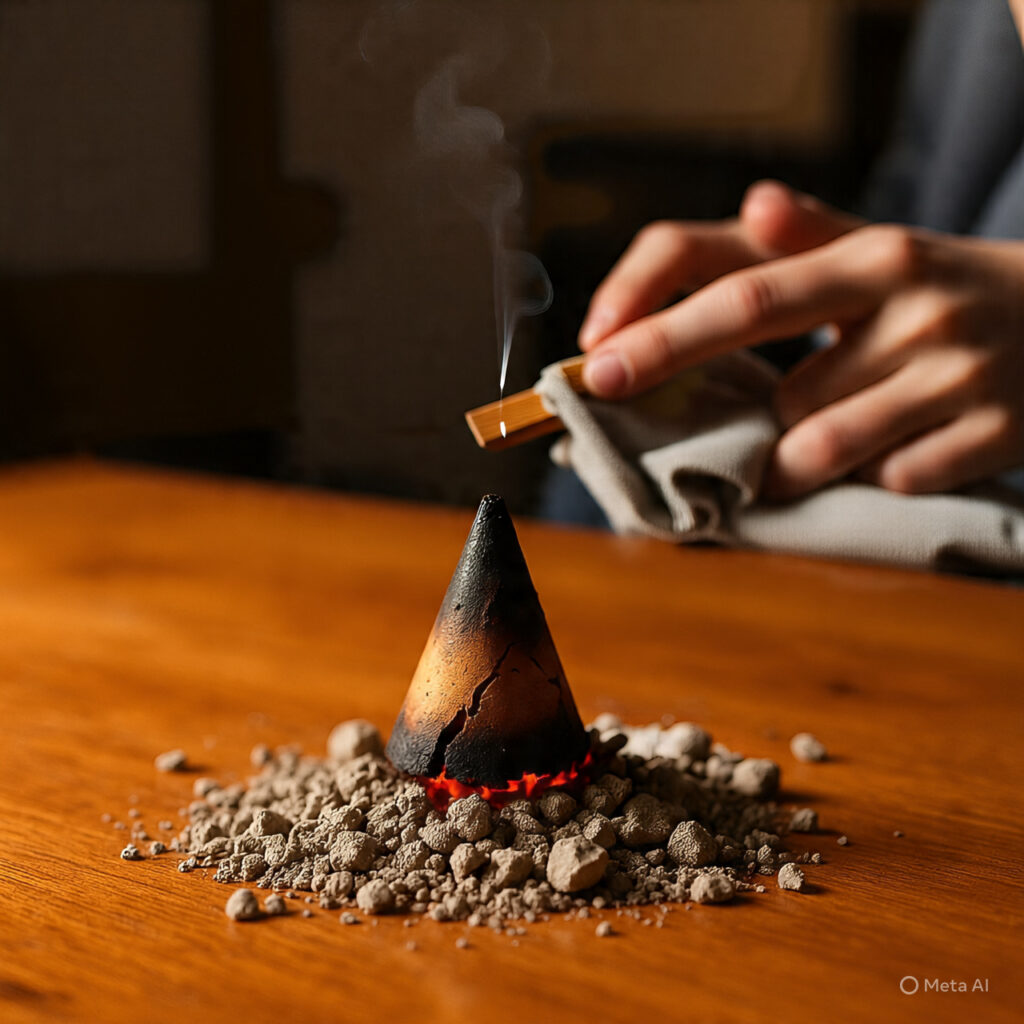
Backflow cones sometimes leave behind burnt oil residue or sticky residue. For burner maintenance, wait until the burner cools, then wipe it gently with a cloth. If the buildup is strong, try the dish soap method or a toothbrush cleaning to remove resin buildup. Regular cleaning frequency keeps your incense burner preservation in good condition and prevents an acrid smell the next time you burn.
Tips for the Best Backflow Effect
Indoor environments provide ideal conditions for consistent waterfall incense displays without interference. Eliminate drafts, fans, and air conditioning currents that disrupt delicate smoke patterns significantly. Well ventilated spaces with stable temperatures enhance cascading consistency remarkably.
Premium cone quality directly impacts visual effects and fragrance dispersal throughout your space. High-grade backflow incense contains balanced oil absorption concentrations and proper density formulations for reliable performance. Cheap alternatives often fail producing disappointing results that waste time and money.
Troubleshooting: Why Is My Backflow incense Not Working?
- Smoke rising instead of falling – This usually happens if you’re not using a proper backflow incense burner or if the hole is blocked.
- Weak or no waterfall effect – Place the cone indoors, away from fans or open windows. Even slight airflow can stop the downward smoke.
- Cone won’t stay lit – The incense tip may not be burning fully. Relight it until a glowing ember with a light ashen edge appears.
- Burner hole clogged – Residue buildup prevents the smoke from flowing. Clean your incense holder regularly for the best effect.
- Strong oily smell or residue – Some low-quality scented cones leave sticky oils. Use premium cones for cleaner burning.
- Smoke flow delayed – It can take 1–2 minutes after lighting before the smoke waterfall effect starts. Be patient.
Benefits of Burning Backflow Incense Cones
Aromatherapy benefits extend far beyond simple visual appeal into therapeutic territory. Cascading smoke creates natural focal points for meditation practices, reducing stress levels and promoting enhanced mindfulness states. The hypnotic movement patterns naturally calm anxious minds effectively.
Home fragrance advantages transform living spaces into sophisticated environments that impress guests consistently. Waterfall incense displays serve as conversation pieces while providing subtle aromatic enhancement throughout rooms. This dual functionality appeals to aesthetic sensibilities and practical needs simultaneously.
| Benefit Category | Specific Advantages |
|---|---|
| Meditation Tool | Enhanced focus, stress reduction |
| Decorative Element | Visual appeal, conversation starter |
| Aromatherapy Session | Fragrance dispersal, mood enhancement |
| Wellness Routine | Mindfulness practice, relaxation |
Safety Precautions When Burning Backflow Incense Cones
Fire safety protocols protect households from potential hazards during incense burning sessions. Never leave burning cones unattended, especially around children or pets who might accidentally disturb equipment. Heat resistant surfaces prevent accidental damage to furniture or flooring materials completely.
Ventilation requirements prevent smoke accumulation in enclosed spaces that might cause discomfort. While enjoying backflow aromatherapy, maintain adequate air circulation for comfort and safety. Respiratory sensitivities require extra caution during extended burning sessions to prevent irritation.
How to Clean and Maintain Your Backflow Burner
After each session, you will notice ash formation and sometimes burnt oil residue. Cleaning is important to keep your incense fountain looking beautiful.
Use these simple steps for incense burner cleaning:
- Let the burner cool down completely.
- Remove all incense ash disposal with a soft brush.
- For sticky buildup, use warm water and mild soap.
- A soft toothbrush works best for residue removal in small corners.
- Dry fully before the next use to prevent cracks.
Regular burner maintenance not only improves performance but also makes your wellness routine safe and enjoyable.
Best Scents for Backflow Incense Cones
Sandalwood and lavender represent popular choices for relaxation purposes among experienced practitioners. These classic fragrances complement waterfall effects while promoting tranquil atmospheres perfect for evening sessions. Personal preferences guide optimal scent selection processes effectively.
Energizing fragrances like citrus or peppermint suit morning meditation sessions beautifully. Evening rituals benefit from calming jasmine or patchouli varieties that encourage deeper contemplation. Experiment with different backflow incense scents to discover personal favorites that enhance your practice.
Backflow Incense Cones vs Regular Incense
Design differences create distinctly different user experiences between these two incense formats. Traditional incense sticks offer longer burning times and stronger fragrance throw throughout larger spaces. Backflow varieties prioritize visual spectacle over extended aromatherapy duration exclusively.
Cost considerations favor regular incense for daily spiritual practices and routine use. Backflow incense investment yields premium experiences suited for special occasions or dedicated meditation rituals. Both formats serve unique purposes effectively without direct competition.
Frequently Asked Questions (FAQs)
How to light incense cones for waterfall?
To light a backflow incense cone, hold the pointed tip with a lighter or match until it catches flame. Let it burn for 5–10 seconds, then gently blow it out. The tip should glow with a small ember and start releasing smoke. Place it on your backflow incense burner to enjoy the downward smoke waterfall effect.
Why doesn’t my incense waterfall work?
If the smoke waterfall effect isn’t appearing, check for airflow around your burner, as fans or open windows can disrupt it. Also, ensure the burner hole is not blocked with residue or ash. Use only backflow incense cones, since regular cones won’t create the downward smoke flow.
How do the incense waterfalls work?
Backflow incense cones are designed with a hollow tunnel inside. As the cone burns, the smoke becomes denser than the surrounding air and flows downward through the hole of the incense burner, creating a cascading smoke waterfall. This unique design is what makes them different from regular cones.
Do you burn incense cones from the bottom for waterfall?
No, incense cones should always be lit from the pointed tip at the top, never from the bottom. Lighting from the bottom will destroy the cone and prevent the backflow smoke effect. Once lit at the tip, place the cone on your burner’s hole and wait for the smoke to flow downward.
What is the difference between incense cones and backflow cones?
Regular incense cones release smoke upward, while backflow incense cones are specially designed with a hollow center that directs smoke downward. This allows them to create the signature smoke waterfall effect when used with a proper backflow burner.
Why won’t my cone incense stay lit?
If your cone keeps going out, it may not have been lit long enough. Hold the flame on the tip until a small glowing ember forms, then blow out the flame. Low-quality cones or excess moisture can also cause burning issues. Store cones in a dry place and use high-quality scented cones for the best results.
Final Thoughts
Backflow incense cones are more than just home fragrance. They are a relaxation aid, a mindfulness practice, and a beautiful piece of art. The incense waterfall smoke effect not only fills your home with a calming scent but also creates a calming sight that eases the mind.
By following the right backflow incense instructions, using quality cones, and taking care of your incense burner cleaning, you can enjoy the cascading smoke every day. Whether you use it for aromatherapy incense cones, for spiritual incense burning, or simply for ambient enhancement, the backflow incense burner will bring peace to your space.
If you’re interested in How to Light an Incense Cone, be sure to check out our How to Light an Incense Cone (Step-by-Step Guide for Clean & Even Burn) to explore more unique and dark options!

